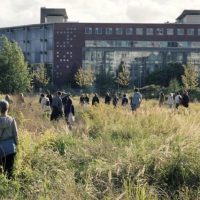Gabriella Csoszó: Way of Cherry Trees, photo installation, 2008
“In 1990 a Japanese Foundation donated 10 000 cherry trees to Berlin, planed along a section of the former wall (it’s total lenght was 160 km) Osdolfer Waldchen and Lichterfelter Allee. The photo installation follows the path of cherry trees at the place of the demolished Berlin Wall.
The Way of Cherry Trees shows the uncertainty of social, political, historical remembrance of our time. The series was inspired by walks along the demolished Berlin Wall where nownowadays cherry trees blossom. Right from the beginning it was a joint work with a co-artist whose name remained almost hidden. Two walks are intertwined in the photo series. I could discover the cherry trees with the help of the co-artist’s descriptions, preliminary studies and draft-photos. I received the images and descriptions of this preliminary walk, and finally I created my own version of this topic, Thus, the two walks ended up as a long series of images accompanied by description.
The suburb locations of Berlin, the haggard and sometimes uninteresting landscapes seem to locate the memorial place of a long forgotten past. This section of the former Berlin Wall became an ordinary walking path.
Katarina Sevic: Social Motions, mass performance, video, 2007
I used Skulpturenpark in Berlin as a stage for a mass choreography. The initial idea for the project was based on the notion of mass ‘patterns’, the connections and contradictions in the very basic of the conceptual, symbolic and aesthetic values of the phenomena of mass (physical) displays. I was always fascinated by the (un)controlled power of a mass and the unified dynamics of individuals under a common goal. I found interesting relationships and similarities between past and present forms of mass displays, such as protests, group gymnastics, ritual gatherings, social movements, processions, and simple everyday routines.
Social Motions experiments with the idea of mass patterns and motions of different scale, defined by our cultures or everyday habits. Whether in order and rehearsed or spontaneous and self-organized, social formations reveal how a society orders itself, and at times, legitimizes certain ideologies.
Performance was documented on photo and video which is will be shown in the exhibition as well.

